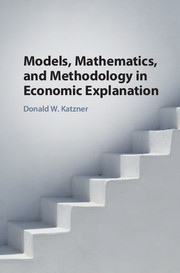Book contents
- Frontmatter
- Dedication
- Contents
- Preface
- Introduction
- 1 Science and Economics
- 2 Economic Models and Explanation
- 3 The Stages of Model Building in Economics
- 4 Models and Mathematics
- 5 Models and Measurement (or Lack Thereof)
- 6 Issues Relating to the Construction of Models from Scratch
- 7 An Example: The Efficiency of Organizational Forms
- 8 The Implicit Assumption Requirements of Later-Stage Model Building
- 9 Ordinality and the Adequacy of Analytic Specification
- 10 Categories of Models
- 11 Conclusion
- Index
3 - The Stages of Model Building in Economics
Published online by Cambridge University Press: 26 October 2017
- Frontmatter
- Dedication
- Contents
- Preface
- Introduction
- 1 Science and Economics
- 2 Economic Models and Explanation
- 3 The Stages of Model Building in Economics
- 4 Models and Mathematics
- 5 Models and Measurement (or Lack Thereof)
- 6 Issues Relating to the Construction of Models from Scratch
- 7 An Example: The Efficiency of Organizational Forms
- 8 The Implicit Assumption Requirements of Later-Stage Model Building
- 9 Ordinality and the Adequacy of Analytic Specification
- 10 Categories of Models
- 11 Conclusion
- Index
Summary
As described in Chapter 2, economic behavior or the consequences of that behavior are frequently the subject matter of explanatory economic models. Models of this sort can be built for the purpose of explaining, respectively, certain aspects of a phenomenon that are observed or how an economic phenomenon generates outcomes. In the first instance the emphasis is on themodel's structure; in the second it is on the model's output.When there is interest in the model's output either as the main focus of the model or as a by-product, one of at least two styles of outputs may emerge. These styles give rise to what has been called the multi- or function-output model and the single- or variable-value-output model.
It should also be recalled that the function-output model is often built on the foundation of economic choice. From Hausman's perspective [11, p. 73], the structure of the standard model of choice consists of preferences (in the general sense of judging one alternative to be better than or equally as good as another), beliefs, and constraints as determinants of choices. With respect to the traditional multi-output model of consumer demand, individual preferences and beliefs are combined into a preference ordering among baskets of commodities, and preference orderings and price-income constraints combine to determine choices and hence behavior [11, p. 19]. In the case of the firm, the typical model sets out to show how the firm's operating decisions are determined: First, its preference ordering among input mixes and output levels is developed as dependent on constraining prices and resource endowments, beliefs about technological possibilities, and the firm's desire for larger net returns. These preferences then generate the firm's choices and behaviors [11, p. 42]. The models that produce the behavioral functions described here can be combined and enlarged to obtain the general equilibrium model whose structure fabricates an output that is a collection of variable values consisting of prices and quantities across the microeconomy. In this sense, the general equilibrium model is a variable-value-output model. However, building the general equilibrium model could also be interpreted as having as its only objective the description of a possible structure that explains how the general microeconomy operates. This chapter is concerned with the procedure whereby the function-output and the variable-value-output models are constructed.
- Type
- Chapter
- Information
- Publisher: Cambridge University PressPrint publication year: 2017



